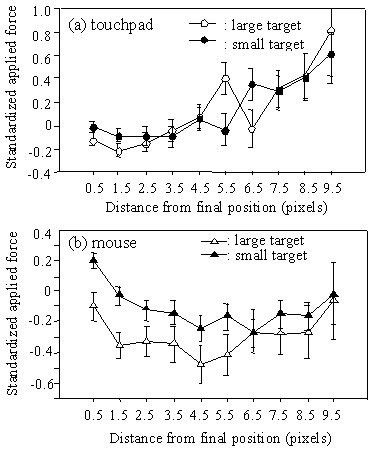Akamatsu, M., & MacKenzie, I. S. (2000). Changes in applied force to a touchpad during pointing tasks. Proceedings of IEA 2000, p. 1-359. Santa Monica, CA: Human Factors and Ergonomics Society.
Changes in Applied Force to a Touchpad During Pointing Tasks
Motoyuki Akamatsu1 and I. Scott MacKenzie2
1National Institute of Bioscience and Human TechnologyTsukuba, JAPAN
2Dept. of Mathematics & Statistics
York University
Toronto, CANADA
ABSTRACT
We measured the force applied to a touchpad and a mouse during pointing tasks for large and small targets. At the end of selection tasks, changes in the applied force with the touchpad were different from those with a mouse. These differences may be the source of performance differences between the two devices.
INTRODUCTION
A touchpad is a common input device for notebook computers. However, pointing performance is poor in comparison with a mouse. This research is motivated by the need to improve the touchpad as an input device -- to bring it closer to a mouse in pointing performance. To learn how users operate the touchpad during pointing tasks, we measured the force applied to the touchpad. We also measured the force for the same tasks performed with the mouse.EXPERIMENT
Apparatus
The touchpad and mouse were operated on a plate instrumented with a high-sensitivity three-axis strain gauge. The touchpad was directly fixed to the plate and, when the mouse was used, the mouse pad was fixed on the plate. To avoid artefacts in recorded force, the click button was separated from the devices and was operated by the left hand. When the click button was pressed, a trial started. The trial was terminated when the participant pressed the click button after the cursor was within the target area. The signal of the strain gauge and the trace of the cursor during the task were recorded at a 33.3 Hz sampling rate.Experimental Design
Four participants performed selection tasks with four target directions (45°, 135°, 225°, 315°) and two indices of difficulty (ID). The target was a circle with either 10 or 40 pixels as the diameter. The distance from the initial cursor position to target centre was 160 pixels. Therefore, the IDs of the tasks were 2.3 bits and 4.1 bits.RESULTS
From the recorded traces, the distances from the target centre to the final position of the cursor during the tasks were calculated. The amplitudes of applied force to the device were obtained from the sum of the squares of the forces measured along the three orthogonal axes.Figure 1 shows the relationship between the distance to the final cursor position and the amplitude of force to the touchpad. The figure shows that, in general, the applied force was reduced as the cursor approached the target. However, just before the subject stopped the cursor, there was small increase in the force. For the smaller target, the final increase of the force was higher than for the larger target. When the subjects used the mouse, the force was relatively constant until the cursor position was 30 or 20 pixels to the final position. Then, a gradual increase of the force was observed. The amplitudes of the force were higher for the smaller target than for the larger target.
The results suggest that, when users operate the mouse, they press the mouse with increased friction in precisely locating the cursor in the target region. On the other hand, when they operate the touchpad, they reduce the applied force while approaching to the target. It is considered that such a reduction in force is an unnatural behaviour for position tasks. From this finding, it is suggested that the detected force can be a variable in the touchpad's transfer function to afford a better blend of coarse and fine positioning strategies.

Fig. 1. Changes of applied force during target selection task.